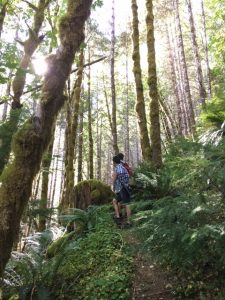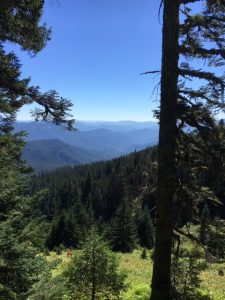Research and Revelation
HJA 1: In the introductory material (pages 1-14) the author asks the fundamental question, “What’s the story here?” After you have read the first chapter, answer the following questions (no more than a short paragraph per answer):
* What do you expect to observe when we visit the forests of the H.J. Andrews?
I expect lots of green, damp plants and trees everywhere. I expect humid, earthy smells lofting through the forest. We would probably walk on set paths and see the trails as we go through the forest. I also imagine a small stream bubbling in the distance while we walk and hike through this area.
* What are some different ways of telling the story of these forests? How do methods of creative reflection support scientific inquiry and vice versa?
There are many different ways of telling the story of these forests. There are creative ways such as photographs, anecdotes, essays and poems. And there are scientific ways such as through data and graphs.
“It’s our belief that creative writers and those who undertake other types of arts-and humanities-based inquires can be especially adept at bringing scientific information and insights into conversation with the complex emotional and cultural relationships that humans have with both wild and managed landscapes”(9).
Scientific inquiry can bring us realistic, hard data insight into creative minds and draw on scientific inspirations in their works.
“Creative writers draw on rich vocabulary and conceptual insights of science to help people understand and value the world” (11).
* Why is the long-view critical to understanding the role of humans in the natural world?
The long view helps remind us that we can never find a permanent conclusion because societal and environmental context constantly changes around us. As humans of the natural world, we have to be attuned for the past, present and future to see out ever-changing world around us.
HJA 2-4: For each of the main sections of the book (Part One, Two, and Three), read the Ground Work essays and at least three other entries for the section. Then answer the following questions (no more than a short paragraph per answer):
* Why was this theme chosen (e.g., Research and Revelation for Part One) to tell the story of the H.J. Andrews Experimental Forest?
The writers conducted the research by entering the forest and collecting data for their stories, just as scientists do. From the research of entering the forest, they experience, write down their data, and translate data in forms of poems and stories instead of hard numbers and facts like scientists and researchers do. Writers express in words and sensory imagery while scientists analyze and get hard data.
* What do you expect the landscape to look like from the passages in this section?
I expect the landscape to look mess and chaotic (which is the way nature is), but I expect it to look chaotic in an organized matter. There would be a variety of trees(Douglas-fir, western hemlock, true firs, etc.) scattered throughout with different little insects and beings inhabiting these trees. I expect fresh green moss on logs and everything having a damp touch to it.
* Provide an example or two of how the scientific context presented in the Ground Work essay is reflected in creative storytelling for the section.
In the chapter “Varied Thrushes”, it talks about Oregon Robins. The author uses great detail by using sensory imagery to describe what the bird looks like and the distinct movements made by the bird. In the end, it describes their contact calls to be “subtle, metallic, yet sweet”(29). And in the Groundwork, it describes how there are over 170 bird species reside or visit the Andrews over the course of the year. Also, animals provide “a limited choral complement to the wind soughing through the evergreens and reverberation of streams cascading over boulders.” So I imagine that the forest would be mostly quiet, with the occasional bird call every once in a while.
* What’s a question you have about the forest from reading these passages?
As described in the groundwork, there are thousands of species of invertebrates in a variety of living conditions. How, and how long did it take for researchers to gather all the information about those small invertebrates?
Change and Continuity
HJA 2-4: For each of the main sections of the book (Part One, Two, and Three), read the Ground Work essays and at least three other entries for the section. Then answer the following questions (no more than a short paragraph per answer):
* Why was this theme chosen (e.g., Research and Revelation for Part One) to tell the story of the H.J. Andrews Experimental Forest?
Change and Continuity is to explain how forests change after periods of disaster. The environment around us will never be the same or stagnant. The world is constantly changing and never stopping.
* What do you expect the landscape to look like from the passages in this section?
The H.J Andrew Experimental Forest , or an forest for that matter, will never look quite new. It will always be filled with newborn trees, old deteriorating trees, and varieties of types of trees. The forest will look run down from the periods of natural disasters that it probably faced over the years.
* Provide an example or two of how the scientific context presented in the Ground Work essay is reflected in creative storytelling for the section.
In the Groundwork “Disturbance”, it talks about how forests suffer and researchers can see how disturbance changes the forest and the life in the forest. So the lookout creek flood revealed what species survived, such as the cutthroat trout by finding refuge in slack water close to the stream banks. In the poem “New Channel” by Jeff Fearnside, he writes about his experience of walking along the creek and describes vividly how many fish died, and how other creatures have died such as spiders, caddis flies, waterskippers, etc.
* What’s a question you have about the forest from reading these passages?
I wonder how many other species survived the lookout creek flood other than the cutthroat trout. And if so, how they did so. What about the invertebrates? I imagine it must be difficult to document the smaller insects.
Borrowing Others’ Eyes
HJA 2-4: For each of the main sections of the book (Part One, Two, and Three), read the Ground Work essays and at least three other entries for the section. Then answer the following questions (no more than a short paragraph per answer):
* Why was this theme chosen (e.g., Research and Revelation for Part One) to tell the story of the H.J. Andrews Experimental Forest?
The section “Borrowing Others’ Eyes is attaining a new perspective or a new lens to view the experimental forest.
* What do you expect the landscape to look like from the passages in this section?
I expect it to be very damp, since it does rain about a hundred inches per year on average. Even without rain, there seems to be lots of moisture in general. In the trees, in the flora, and in all the life in general. I also expect it to be quiet with small, quiet nature sounds in the distance.
* Provide an example or two of how the scientific context presented in the Ground Work essay is reflected in creative storytelling for the section.
In the piece “Denizens of Decay” by Tom A. Titus, he writes a piece about the Oregon Slender Salamander and how it it has skin so thin that “the oxygen made by green photosynthetic needles int he canopy movies easily into her body, so thin that the carbon dioxide flows freely outward”(210). The author paints this beautiful picture with words. In the Groundwork “Water”, it explains how water from the soil can move upwards into trees, through the stomata and into the atmosphere.
* What’s a question you have about the forest from reading these passages?
If water is pumped to the atmosphere through many ways, one way being that it is soaked through soil, up the trees and into the atmosphere, what are other ways water is pumped to the atmosphere?
In the Groundwork “Soundscape”, it talks about how stream sound can be used as a cover for some species and deflect other species to quieter locations where stream noise doesn’t complicate communication. What are other uses of stream sound other than this?



Hi Heera!
I enjoyed reading this entry and the pictures that you added to it. I think the first picture really represents the messiness and chaotic nature that you expected to see in the forest, and the second shows how uniform/ peaceful/ open the forest looks when you aren’t trapped under the thousands of trees, which I suppose could be considered the “organized mess,” as you called it.